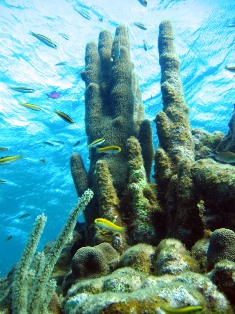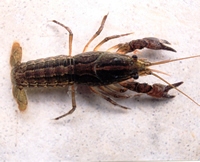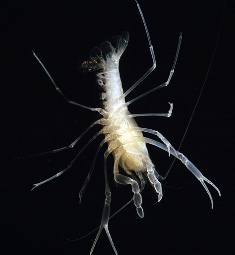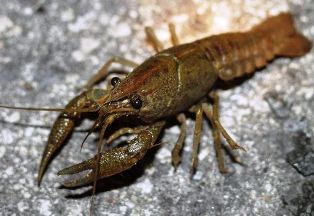Discover Florida Nature
It's time to explore the natural Florida


|
|
|
|
|
|
Invertebrates have four species endangered in the state
of Florida. They have no threatened species at this time, but have four
species of special concern.. Of the million or more animal species in
the world, more than 98% are invertebrates. Invertebrates don't have an
internal skeleton made of bone. Many invertebrates have a fluid-filled,
hydrostatic skeleton, like the jelly fish or worm. Others have a hard
outer shell, like insects and crustaceans. There are many types of
invertebrates. The most common invertebrates include the protozoa,
annelids, echinoderms, mollusks and arthropods. Arthropods include
insects, crustaceans and arachnids. Endangered and at risk invertebrates
in the state of Florida include
corals, crustaceans, insects,
and mollusks Corals- Coral organisms, called polyps, can live on their own, but are primarily associated with the spectacularly diverse limestone communities, or reefs, they construct. Coral polyps are tiny, soft-bodied organisms related to sea anemones and jellyfish. At their base is a hard, protective limestone skeleton called a calicle, which forms the structure of coral reefs. Reefs begin when a polyp attaches itself to a rock on the sea floor, then divides, or buds, into thousands of clones. The polyp calicles connect to one another, creating a colony that acts as a single organism. As colonies grow over hundreds and thousands of years, they join with other colonies and become reefs. Some of the coral reefs on the planet today began growing over 50 million years ago. Coral polyps are actually translucent animals. Reefs get their wild hues from the billions of colorful zoo xanthellae algae they host. When stressed by such things as temperature change or pollution, corals will evict their boarders, causing coral bleaching that can kill the colony if the stress is not mitigated. Corals live in tropical waters throughout the world, generally close to the surface where the sun's rays can reach the algae. While corals get most of their nutrients from the byproducts of the algae's photosynthesis, they also have barbed, venomous tentacles they can stick out, usually at night, to grab zooplankton and even small fish. Coral reefs teem with life, covering less than one percent of the ocean floor, but supporting about 25 percent of all marine creatures.  Pillar
Coral (Dendrogyra cylindrus)
Endangered- Pillar coral are
a type of hard coral which live in the western Atlantic Ocean. They are
one of the digitate corals which resemble fingers, or a cluster of
cigars, growing up from the sea floor, but without any secondary
branching. Pillar corals can grow to be up to 2.5 m (8 ft) tall. They
can grow on both flat and sloping sea floors at a depth of between 1 and
20 m (65 ft). They are one of the few types of hard coral whose polyps
can commonly be seen feeding during the day. Pillar coral, although
beautiful, is rare in the Florida Keys. Pillar coral is unusual in that
its polyps are usually extended for feeding during the day. Most hard
corals feed at night. Pillar
Coral (Dendrogyra cylindrus)
Endangered- Pillar coral are
a type of hard coral which live in the western Atlantic Ocean. They are
one of the digitate corals which resemble fingers, or a cluster of
cigars, growing up from the sea floor, but without any secondary
branching. Pillar corals can grow to be up to 2.5 m (8 ft) tall. They
can grow on both flat and sloping sea floors at a depth of between 1 and
20 m (65 ft). They are one of the few types of hard coral whose polyps
can commonly be seen feeding during the day. Pillar coral, although
beautiful, is rare in the Florida Keys. Pillar coral is unusual in that
its polyps are usually extended for feeding during the day. Most hard
corals feed at night. Crustaceans- Crustaceans are a type of Arthropod. The name may not sound familiar, but you probably know them. You may even have eaten one. Crustaceans live mostly in the ocean or other waters. Most commonly known crustaceans are the crab, lobster and barnacle. Crustaceans have a hard, external shell which protects their body. Crustaceans have a head and abdomen. The head has antennae which are part of their sensory system. The abdomen includes the heart, digestive system and reproductive system.  Panama
City Crayfish (Procambarus econfinae)
SSC (1)- Panama City crayfish
is a species that exists only in a small area of Bay County, Florida.
The crayfish is listed as a species of special concern and protected by
the state of Florida, though not by the federal government. Land
development is the primary cause of the species decline. Since much of
the crayfish’s natural habitat no longer exists, it is necessary to
conserve the remaining habitat. Panama
City Crayfish (Procambarus econfinae)
SSC (1)- Panama City crayfish
is a species that exists only in a small area of Bay County, Florida.
The crayfish is listed as a species of special concern and protected by
the state of Florida, though not by the federal government. Land
development is the primary cause of the species decline. Since much of
the crayfish’s natural habitat no longer exists, it is necessary to
conserve the remaining habitat.  Sims
Sink Crayfish (Procambarus erythrops)
SSC (1)- The Sims sink
crayfish, sometimes called the Santa Fe cave crayfish, is a blind,
albino crayfish that swims through the inky depths of Sims Sink in
northern Florida. A medium-sized white crayfish with reduced eyes, each
of which bears a reddish pigment spot, Sims sink crayfish have an
average body length of 3.5 inches. These colorless crustaceans are among
the few creatures that have adapted to the lightless world at the bottom
of the region's aquifers, springs, and sinkholes. Many species who make
their homes in these freshwater labyrinths are endemic to only a handful
of aquifers and are found nowhere else in the world. Sims
Sink Crayfish (Procambarus erythrops)
SSC (1)- The Sims sink
crayfish, sometimes called the Santa Fe cave crayfish, is a blind,
albino crayfish that swims through the inky depths of Sims Sink in
northern Florida. A medium-sized white crayfish with reduced eyes, each
of which bears a reddish pigment spot, Sims sink crayfish have an
average body length of 3.5 inches. These colorless crustaceans are among
the few creatures that have adapted to the lightless world at the bottom
of the region's aquifers, springs, and sinkholes. Many species who make
their homes in these freshwater labyrinths are endemic to only a handful
of aquifers and are found nowhere else in the world. Black
Creek Crayfish (Procambarus pictus)
SSC- Restricted to a few
small stream systems in Clay, Duval, and Putnam counties in the
northeastern part of the state of Florida, the black creek crayfish
most known localities are within the Black and Rice creek drainages.
This crayfish is medium-sized, growing up to 3 inches long and has a
distinctive pattern of yellowish to white spots and stripes on a dark
brown to black carapace, and a rust-colored abdomen with dark
cross-bands. Crayfish hide during the day in submerged vegetation,
roots, and detritus, but can often be seen crawling along the stream
bottom at night. Black
Creek Crayfish (Procambarus pictus)
SSC- Restricted to a few
small stream systems in Clay, Duval, and Putnam counties in the
northeastern part of the state of Florida, the black creek crayfish
most known localities are within the Black and Rice creek drainages.
This crayfish is medium-sized, growing up to 3 inches long and has a
distinctive pattern of yellowish to white spots and stripes on a dark
brown to black carapace, and a rust-colored abdomen with dark
cross-bands. Crayfish hide during the day in submerged vegetation,
roots, and detritus, but can often be seen crawling along the stream
bottom at night. |
|
|
Advertise | Privacy Statement | Dog Encyclopedia | Video |Contact | Alaska Nature |
|